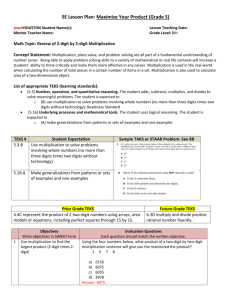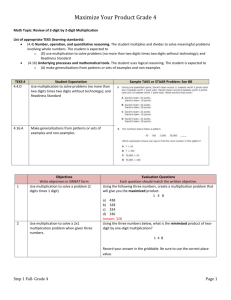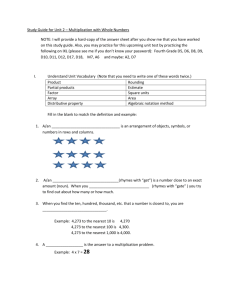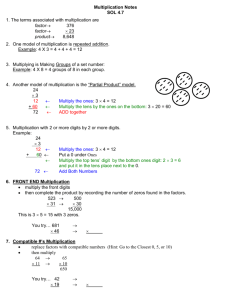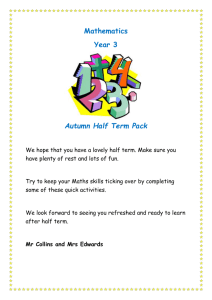Maximize Your Product Grade 5
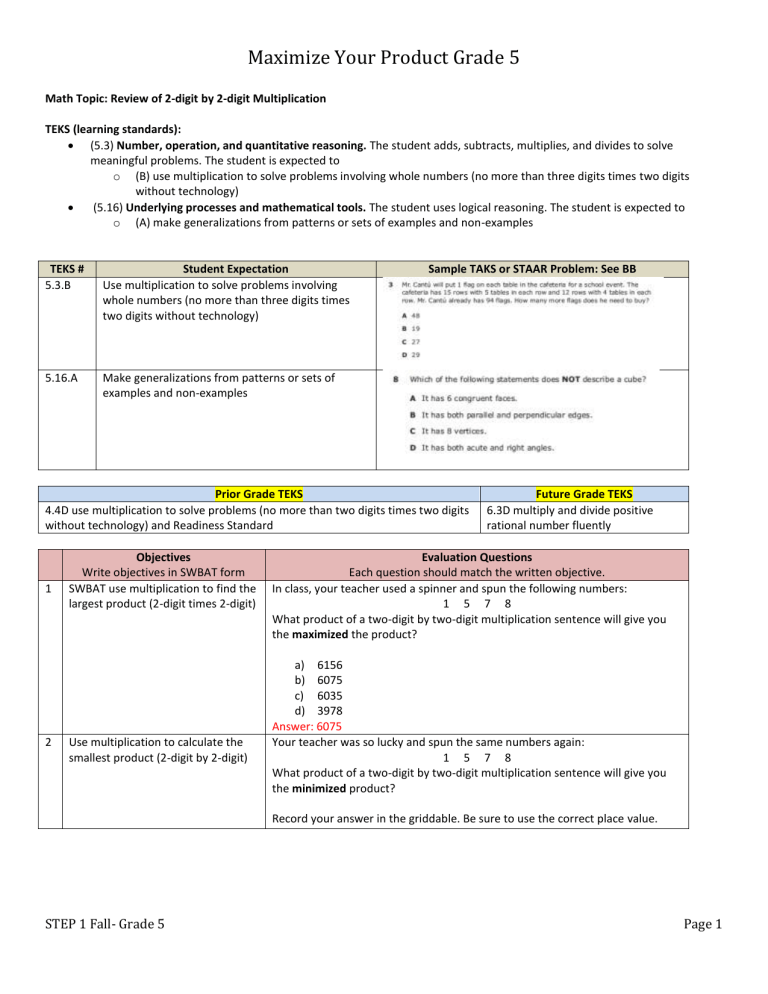
Maximize Your Product Grade 5
Math Topic: Review of 2-digit by 2-digit Multiplication
TEKS (learning standards):
(5.3) Number, operation, and quantitative reasoning. The student adds, subtracts, multiplies, and divides to solve meaningful problems. The student is expected to o (B) use multiplication to solve problems involving whole numbers (no more than three digits times two digits without technology)
(5.16) Underlying processes and mathematical tools. The student uses logical reasoning. The student is expected to o (A) make generalizations from patterns or sets of examples and non-examples
TEKS #
5.3.B
Student Expectation
Use multiplication to solve problems involving whole numbers (no more than three digits times two digits without technology)
Sample TAKS or STAAR Problem: See BB
5.16.A Make generalizations from patterns or sets of examples and non-examples
Prior Grade TEKS
4.4D use multiplication to solve problems (no more than two digits times two digits without technology) and Readiness Standard
Objectives
Write objectives in SWBAT form
Future Grade TEKS
6.3D multiply and divide positive rational number fluently
Evaluation Questions
Each question should match the written objective.
1 SWBAT use multiplication to find the largest product (2-digit times 2-digit)
2 Use multiplication to calculate the smallest product (2-digit by 2-digit)
In class, your teacher used a spinner and spun the following numbers:
1 5 7 8
What product of a two-digit by two-digit multiplication sentence will give you the maximized the product? a) 6156 b) 6075 c) 6035 d) 3978
Answer: 6075
Your teacher was so lucky and spun the same numbers again:
1 5 7 8
What product of a two-digit by two-digit multiplication sentence will give you the minimized product?
Record your answer in the griddable. Be sure to use the correct place value.
STEP 1 Fall- Grade 5 Page 1
Maximize Your Product Grade 5
3 SWBAT explain a strategy that yields the greatest product
Answer: 986
Juan said that Problem A below has a larger product than Problem B. Without calculating the product, explain a strategy that can prove that he is incorrect.
A 46
x 12
B 61
x 42
Possible Answer: If you estimate the factors, problem A is 50 x 10 = 500 while problem B is 60 x 40 = 2400. So, Problem B has a larger product.
Possible Answer: Based on the game strategy, the largest values go in the tens place and the smaller values go in the ones place.
Resources, Materials, Handouts, and Equipment List in the form of a table:
Option 1: Teach From Doc Cam Option 2: Teach From PPT/Smart Board
ITEM Quantity Resource is for… Responsible
Number Cube (check out from 304A) 1
Explore/Elaborate: “Maximize Your Product” worksheet 30
Explain: Graphic Organizer 30
Evaluate: “Maximize Your Product” 30
Teacher and Students
Students
Students
Students
Partner A
Partner B
Partner B
Partner A
Powerpoint (inserted as an Object):
Maximize_Gr5.pptx
STEP 1 Fall- Grade 5 Page 2
Maximize Your Product Grade 5
5E Lesson Plan
Objective Statement: Today we will practice multiplication by making generalizations from patterns in a game.
ENGAGEMENT Time: 3 minutes
What the Teacher Will Do
Probing/Eliciting Questions and Students
Responses
What the Students Will Do
The teacher asks engaging questions to grab attention of students that relate to the activity.
The teacher displays the “Carnival
Candy” problem on the PPT slide.
The teacher selects one student to read the “Carnival Candy” problem out loud.
The teacher selects several students to share their suggestions or questions for solving the “Carnival
Candy” problem without doing any calculations.
The teacher concludes the discussion about the “Carnival Candy” problem before any final answer is given or any resolution to the problem is found. The teacher and students will revisit the problem at the end of the lesson.
Who likes candy?
[Students will all raise hands.]
What is your favorite candy?
-Starbursts
-Sour patch kids
-Lollipops
Who wants as much candy as possible?
[Students will all say yes.]
What is <Insert Principal’s Name> looking for?
-<Insert Principal’s Name> wants to buy candy from a store that will give her the most lollipops.
Without doing any multiplication, which store do you think has more lollipops for
<Insert Principal’s Name> to buy? Why?
-The Sweet Shop because they have so many more bags of lollipops than the other store.
-The Candy Shack because even though there are fewer bags, there are more lollipops in every bag.
Is there any way for <Insert Principal’s
Name> to be sure before she chooses a store?
-Yes, <Insert Principal’s Name> could count each bag and how much candy is inside each bag.
-Yes, she could multiply the value of the bags with how many lollipops come in the bag.
Students will answer engaging question posed by the teacher.
A student volunteer will read the “Carnival Candy” problem out loud.
In pairs, students will spend 2-4 minutes discussing the problem and if it can be done without doing any multiplication.
Student will share their thoughts about the “Carnival Candy” problem so far.
Transition Statement
You will have a chance to continue thinking about the “Carnival Candy” problem at the end of the lesson. For our next activity, we will play a game called “Maximize Your Product.” While you play the game, think about how the game might help you find the answer to the “Carnival Candy” problem.
STEP 1 Fall- Grade 5 Page 3
Maximize Your Product Grade 5
EXPLORATION
What the Teacher Will Do
The teacher displays the
“Maximize Your Product” sheet on the PPT.
The teacher passes out the
“Maximize/ Minimize Your
Product” worksheet and presents students with the
“Maximize Your Product” slide.
The teacher will suggest to the students to consider this knowledge in order to win the game.
The teacher will pick on students to randomly generate numbers by rolling the number cube.
For the first game, the teacher tells the students to write the first rolled number on their worksheet in 1 of the 4 rectangles.
The teacher will instruct students that once they pick a spot for the number, they may
not change its location.
After all students write in the number, the teacher picks 3 more students to roll the number cube one time each, waiting between each roll for students to write the number in one of the rectangles.
NOTE: Do not allow rolled numbers to be repeated more than once.
After all four numbers are placed, the teacher directs the students to multiply their factors.
The teacher will direct students
Probing/Eliciting Questions and Student
Responses
What does maximize mean?
-Make the biggest or make large
What is a product?
-A product is what you get when you multiply two numbers together.
-The answer to a multiplication problem.
So what do you think the point of the game will be?
-To make the biggest answer to a
multiplication problem
What do you call the 2 numbers that you multiply together to get a product?
-Factors
What place value is this top right spot?
-Ones
What place value is this top left?
-Tens
Who has other people in their group with the number in the same spot?
-[Various students will raise their hands]
Who put it in this box?(Going through each box on the worksheet)
-[Ask students to raise hands.]
Raise your hand after you and your group/partner has checked that the multiplication is correct. Who has the largest product?
-[Students will identify students with the largest product]
[Student volunteer], can you please come to the board and show us how you multiplied to get the largest product?
-[Student comes to the board.]
Time: 12 minutes
What the Students Will Do
A student volunteer will pass out the “Maximize Your Product” activity sheet.
Students will answer as a whole group for this section of questions.
Each student will receive Maximize and Minimize worksheet.
Maximize.Explore.Ela
borate.docx
Students are organized into small groups or pairs.
Students will volunteer to roll the number cube to randomly generate numbers.
After each number cube roll, each student writes the number rolled in one of the four rectangles on the first multiplication template. Once they choose a space for a number, they may not change its location.
After all 4 numbers have been placed students multiply their 2 digit numbers together. The goal of the game is for students to try to get the largest possible product.
Students compare their answers in their groups. Students will compare the placement of their 4 numbers with those of their partners or group members and determine a strategy for the next game or round.
STEP 1 Fall- Grade 5 Page 4
to share strategies with their group to find the largest product, and to come up with one group strategy they can use for the next game.
The teacher will direct the students to write their group strategy in the corresponding box labeled “strategy” under the first multiplication template.
The teacher will determine who has the largest product by asking students with the largest products in their groups to stand up. The teacher will continue to ask students their products until only students with the largest product remains standing.
The teacher asks the student with the correct answer to come to the board to explain that his multiplication is correct.
The teacher asks the student volunteer to share their strategy.
The teacher repeats the game several times.
1 st & 2 nd game: one roll at a time (4 students)
3 rd game: 2 numbers at once, last 2 rolled one at a time (3 students)
4 th game: 3 numbers at once, last number rolled alone (2 students)
5 th game: 4 numbers rolled at once (1 student)
6 th game: numbers greater than 6 given by teacher.
Note: The explanation section of the lesson may occur between each game.
Maximize Your Product Grade 5
What strategy did you use to decide where to write 1 of the rolled numbers?
-If a large number was rolled, then I put that in the 10s place.
-If a smaller number was rolled, then I put in the 1s place.
How does the placement of your numbers compare with that of your neighbor’s? How does their product compare to yours?
[Answers will depend on the numbers rolled and students’ placement of the numbers.]
- My partner put a higher number in the tens
place than I did and she got a larger product.
What patterns do you see that help create the largest product? Write this on the bottom of your activity sheet.
-When the 2 factors are closer together, they tend to make a larger product; when the 2 factors are farther apart, they tend to make a smaller product.
-The big numbers should be put in the tens place.
If I gave you all 4 numbers, do you think you could place them in the correct spot for the maximized product?
-[Most students should reply, “Yes.”]
Students will write their group strategy in the corresponding box under the first multiplication template.
A chosen student will show on the board that his answer is correct.
The student will explain his/her process to multiply the numbers.
Students will use the next multiplication template and play the game again using what they learn each time to try and obtain the highest product.
STEP 1 Fall- Grade 5 Page 5
Maximize Your Product Grade 5
Transition Statement
Now that you have used a strategy to place the 4 numbers to maximize the product, we will talk about the strategies you discovered as a class because we are practicing multiplication.
EXPLANATION
What the Teacher Will Do
Teacher will pass out graphic organizer.
The teacher will tell the students to talk in their groups about their strategies to maximize the product.
Teacher will have students share some of their group strategies with the class.
Teacher asks students questions that will encourage them to share their ideas.
Teacher will ask students if other students “agree or disagree” and justify why.
Teacher instructs students to write their ideas and examples on the “Maximize” side of the graphic organizer.
Time: 10 Minutes
Probing/Eliciting Questions and Student
Responses
What was 1 of your strategies? Why did you place the numbers in those locations?
-I applied the patterns I saw in the previous examples and tried to place the higher numbers in the tens column. I also tried to create 2 factors that were closer together because I noticed their products were larger than 2 factors whose values were farther apart numerically.
How can you be sure that this is the largest product?
-I tried some other arrangements and they all had lower products.
-Yes, based on the patterns I have seen so far.
If I changed the value of 1 of the 4 rolled digits to another number (give example), how would your placement of the values differ?
[Answers vary based on numbers rolled.]
- If I was waiting for a 5 or a 6 to put in the tens place, but I never got one, so now I would put the 4 in the tens place since it is the biggest number.
What is the pattern for where to place the largest digit and the smallest digit?
-The largest number goes in the tens place and the smallest number goes in the ones place of the other factor. The next largest number goes in the tens place of the factor with the smallest number in the ones place. The next smallest number goes in the ones place with the largest factor in the tens place.
Why does the largest digit need to be in the 10s place and the smallest digit in the
1s place?
-Because if the numbers were 1 and 6, that would be 61 times a number instead
What the Students Will Do
Students will discuss with their partner/groups the strategies to get the maximized product.
The selected students will explain the reasoning behind their number placements and show the steps of their 2 digit multiplication on the board or overhead.
All students evaluate the processes presented to make sure the product is correct.
Students will justify their thinking.
Students will share out strategies they used to maximize their product.
Maximize_Explanatio n.docx
Students will write suggested strategies, along with an example and a non-example, in their organizer.
STEP 1 Fall- Grade 5 Page 6
Maximize Your Product Grade 5 of just 16 times a number. So the larger number needs to be in the tens place.
That’s approximately 60 times vs. 10 times.
Why do you pair the least digit with the largest digit?
-When multiplying 61 x 32 you are multiplying 60x2 and 1x30, or 150. In contrast, if you multiplied 62 x 31, then that would be 2 x 30 and 60 x1, or 120.
This is less than the prior method.
What other patterns do you see?
-Two factors that are closer together in value seem to have higher products than two factors that are farther apart in value, assuming both numbers use the highest digits in the tens place.
Transition Statement
You have seen many patterns in our game to try and maximize your product. Now we will play the game again, but this time your goal is to find the strategy to minimize the product.
ELABORATION
What the Teacher Will Do
The teacher instructs the students to use the “Minimize Your
Product” activity sheet and asks questions to the class to determine the goal of this game.
Once again, the teacher will pick on students to randomly generate numbers by rolling the number cube.
Teacher will use the same rolling strategy as in the “Maximize your
Product” game:
1 st & 2 nd game: one roll at a time (4 students)
3 rd game: 2 numbers at once, last 2 rolled one at a time (3 students)
4 th game: 3 numbers at once, last number rolled alone (2 students)
5 th game: 4 numbers rolled at once (1 student)
6 th game: numbers
Probing/Eliciting Questions and Student
Responses
What does it mean to minimize?
-To make smaller.
How will your strategy be different for minimizing as compared to maximizing the product?
-This time I will try to put lower numbers in the tens place.
What patterns do you see in this game?
-I see the same patterns only opposite.
For example, now I am trying to make two numbers that are farther apart in order to get the smallest product.
What strategy would you use to
minimize the product?
-The smallest number goes in the tens place and the largest number goes in the ones place of a different factor. The next smallest number goes in the tens place where the largest number is in the ones place. The next largest number goes in the ones place next to the smallest number.
STEP 1 Fall- Grade 5
Time: 10 minutes
What the Students Will Do
After each roll (or given set of numbers), students write the number in 1 of the 4 rectangles in the first multiplication template. Once they choose a space for a number, they may not change its location. After all 4 numbers have been placed; students multiply their 2 digit numbers together. The goal of the game is for students to try to get the smallest possible product.
Students will rearrange the numbers on the worksheet so that they can see the pattern and strategies that need to be used.
Page 7
Maximize Your Product Grade 5 greater than 6 given by teacher.
Note: If running low on time, the teacher may give the students the numbers they are to use for each game.
Teacher will direct students to write their strategies as they play in the designated box on the
“Minimize Your Product” handout.
Teacher will have students discuss in their groups strategies for picking the smallest product.
Teacher will have students with the smallest product in each group stand up.
Teacher will direct students to share their products until the students with the smallest product remain standing.
The teacher will select a volunteer to share his answer and strategy for coming up with the smallest possible product.
Teacher instructs students to write their ideas and examples on the “Minimize” side of the graphic organizer.
The teacher will then have students discuss as a class the differences between strategies for maximizing and minimizing products.
Once all “Maximize the Product” templates are used, the teacher remind will remind the students of the “Carnival Candy” problem and asks them if they can solve the problem now.
STEP 1 Fall- Grade 5
If I changed the value of 1 of the 4 rolled digits to another number (give example), how would your placement of the values differ?
[Answers vary based on numbers rolled.]
- If I was waiting for a 5 or a 6 to put in the ones place, but I never got one, so now I would put the 4 in the ones place since it is the biggest number.
What is the pattern for where to place the largest digit and the smallest digit?
-The largest number goes in the ones place and the smallest number goes in the tens place of the other factor. The next largest number goes in the ones place of the factor with the second smallest number in the tens place. The smallest number goes in the tens place with the largest factor in the ones place.
Why does the largest digit need to be in the 1s place and the smallest digit in the
10s place?
-Because if the numbers were 1 and 6, that would be 16 times a number instead of just 60 times a number. So the smallest digit needs to be in the tens place to get the smallest product. That’s approximately 10 times a factor vs. 60 times a factor.
Why do you pair the least digit with the second largest digit?
-When multiplying 13 x 26 you are multiplying 10x6 and 3x20, or 120 total. In contrast, if you multiplied 16 x 23, then that would be 10 x 3 and 6 x20, or 150.
This is more than the prior method.
What advice would you give <Insert
Principal’s Name> to buy the most candy for the carnival? Why?
-<Insert Principal’s Name> should go to
The Sweet Shop because those numbers are closer together so when you multiply
Students will share out strategies they used to minimize their product.
A chosen student will show on the board that his answer is correct and they will explain their process to multiply the numbers.
Maximize_Explanatio n.docx
Students will write suggested strategies in their organizer.
Students will apply what they have learned during the “Maximize Your
Product” game to answer the “Carnival
Candy” problem.
Students will calculate how many
Page 8
Maximize Your Product Grade 5 them you would get a larger product lollipops are at each store to confirm their answer to the “Carnival Candy” problem.
Transition Statement
Congratulations, we have explored maximizing the product, we explained strategies to maximize the product, and we elaborated those strategies by minimizing the product. Now you will have the opportunity to show what you have learned.
EVALUATION
What the Teacher Will Do
Teacher distributes the evaluation for students to complete.
The teacher will instruct students that they have 5 minutes to complete the given assessment on their own.
Probing/Eliciting Questions
Did you write your name on the top of the paper?
Time: 5 minutes
What the Students Will Do
Students will work on the evaluation individually.
Maximize_Gr5_Evalu ation.docx
